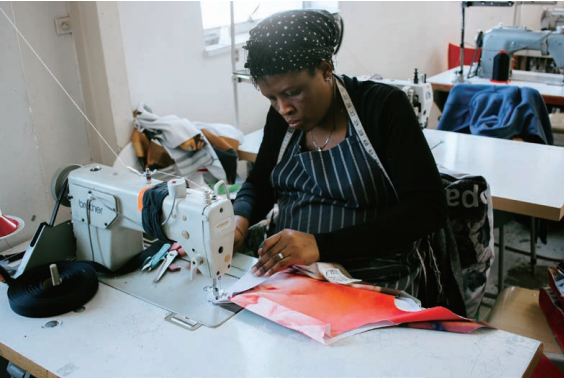City Stories | Cape Town, South Africa: Western Cape Industrial Symbiosis Programme (WISP) delivered by GreenCape

The industrial area north of Cape Town known as Atlantis is the kind of place where business owners keep to themselves. Between the roar of machinery and the rumble of trucks, commercial neighbors in Atlantis don’t have a custom of getting to know each other. Such was the case for Louis Roux, who runs West Coast Plastics. His company takes in polypropylene, high-density polyethylene, and low-density polyethylene plastics from waste-pickers, granulates the material into smaller pieces, washes and dries it, and finally makes new pellets which it sells back to the plastic industry.
In 2018, Roux received a visit from GreenCape, a charitable organization supporting green economic development. The representative described something called the Western Cape Industrial Symbiosis Programme, or WISP, which pairs compatible industrial users in an effort to divert materials from landfills.
“Within a couple months they invited me to a get-together with the other business owners and associates in Atlantis,” said Roux. “It was a nice fruitful day where you can interact with other businesses in your own area and look at some synergies.”
Roux eventually hit it off with an extrusion company called Quality Crate Manufacturers. “Oliver from GreenCape said there’s a new guy on the market and you should give him a call,” Roux said. “We’ve been working together ever since.”
Today, Quality Crate buys 30-50 tons per month from Roux. “He’s my biggest client at this stage,” he said. “I would never have known about him.” In another introduction, Roux also found new suppliers of raw material from a company that collects scraps from big corporations and factories.
These kinds of success stories are the bread and butter of WISP, which began in 2013 with support from the Western Cape provincial government and continues to operate since 2016 with financial support from the City of Cape Town.

The need for WISP arose when the city learned in 2013 that its landfills had only three years of capacity left. “There was a lot of pressure on landfills from companies disposing of waste,” said WISP program manager Emmanuele Kasese. “There is a lot of pressure on the municipality to reduce the amount of waste.” Over the last eight years, WISP takes credit for diverting 88,000 tons of material from landfills, which has given additional life to the stressed municipal landfills.
While there are many ways to divert waste from landfills, WISP’s major benefit coincides with the province’s green economy strategy. It is a low-cost intervention and it creates jobs. “You fund it and industry does the work on your behalf,” Kasese said.

Industrial symbiosis programs are not new. They already exist in Denmark, Finland, and Hungary, among other places. The UK’s National Industrial Symbiosis Programme was the direct inspiration for WISP, whose backers embarked on a study tour to see the UK model firsthand.
“The skeleton is based on the UK model, but context always matters,” said Kasese. “This is a facilitated program with people on the ground driving the work as opposed to industrial symbiosis work that is organic. Once you put people on the ground to visit companies, identify materials, and determine how material can be valued, then you expedite the whole process.”
WISP has a cross-disciplinary team of five full-time facilitators who come from both environmental and engineering backgrounds. The team has helped match industries that do not normally communicate with one another. For example, biodiesel from cooking oil has a byproduct – glycerine or glycerol – which can be used as a dust suppressant in the construction industry.
In one notable success, WISP paired a manufacturer of gypsum board, who was a heavy landfill user, with an entrepreneur who recycles 350 tons of gypsum per month into fertilizer for farms.
But not every pairing works out. Sometimes it costs more to upgrade the waste to usable material than to buy new material. Other times the distance between two companies makes for inefficient logistics, whereby it’s cheaper to dump at the landfill. Or the hurdle can be legislative, such as the requirement for expensive waste management licenses. That requirement was an obstacle when WISP hoped to connect foundries that make engine blocks with a brick maker, who could use the 30 tons of green sand byproduct generated annually. However, heavy metals sometimes leech into the green sand, which makes it hazardous material that requires a special license.
In these cases, Cape Town takes a more active role than just providing funds. “The city tries to lobby the national Department of Environmental Affairs to relook at some of those legislative components,” Kasese said. In general, however, GreenCape is the public face of WISP rather than a government entity.
“Having WISP implemented by a separate entity meant that the program had a degree of independence from the Western Cape government,” said Ellen MacArthur Foundation Policy Research Officer Helena O’Rourke-Potocki. “As the businesses involved in the program were not interacting directly with the public authorities, it was easier to build a trusting relationship with GreenCape. The choice of having an industrial symbiosis program run in-house or by a separate entity depends on the local context and which model will best suit the needs of the program.”
For Roux, the meet-and-greet was a welcome personal touch in an impersonal industry. “We were working three to four kilometers away and we didn’t know each other,” he said. The experience left a favorable impression. “The City of Cape Town supports and backs business whereas I don’t think the rest of the country is so diligent,” he said. “I’m quite impressed.”
Read More: guangzhouaward.org/a/3100.html?lang=en


 In Focus | World Cities Day: People-Centred Smart Cities
In Focus | World Cities Day: People-Centred Smart Cities City Stories | Fostering community resilience: A lifeline for the Central African Republic
City Stories | Fostering community resilience: A lifeline for the Central African Republic In Focus | Innovative Education, Empowering Futures
In Focus | Innovative Education, Empowering Futures




















 Tel: +86 020 3780 4434
Tel: +86 020 3780 4434 Email: info@guangzhouaward.org
Email: info@guangzhouaward.org Adress: Unit 01-7, 28th Floor, No. 7, Chunrong 3rd Road, Tianhe District, Guangzhou, Guangdong, 510000, PRC
Adress: Unit 01-7, 28th Floor, No. 7, Chunrong 3rd Road, Tianhe District, Guangzhou, Guangdong, 510000, PRC




